|
The
Great Censorship
Act 2005 - oops, Defamation Act 2005
(EXTRACT
the entire document is to be posted 3/3/2014)
Extract
published on Redleg-v-Artists 9:35 AM 28 December
2013
By way of actions Cripps undertook against artists
who exhibited their works at his gallery, being
actions similar in nature to those he employed against
us, he caused his gallery to fail. That is, Cripps
acted in a similar (unprofessional) way with other
artists as he did with us and these actions caused
his business to fail.
However, Cripps is suing us because defamation law
in Anglo-Australia allows him to sue us because of his
own actions, not ours, actions that he alone
undertook, which caused his business to fail.
Under the bizarre principles of Anglo-Australian law,
a "defamatory publication" is not a lie, it is not a
falsehood. A "defamatory publication" is ANY
publication written about someone:
"... that a reasonable person would think less of
[them] after reading it..."
( quoting Mark Pearson, from Crikey, http://www.crikey.com.au/2013/09/12/if-hanson-young-can-sue-zoo-what-about-those-daily-tele-shockers )
But apparently, this is not supposed to be a
censorship law? Who's kidding who here?
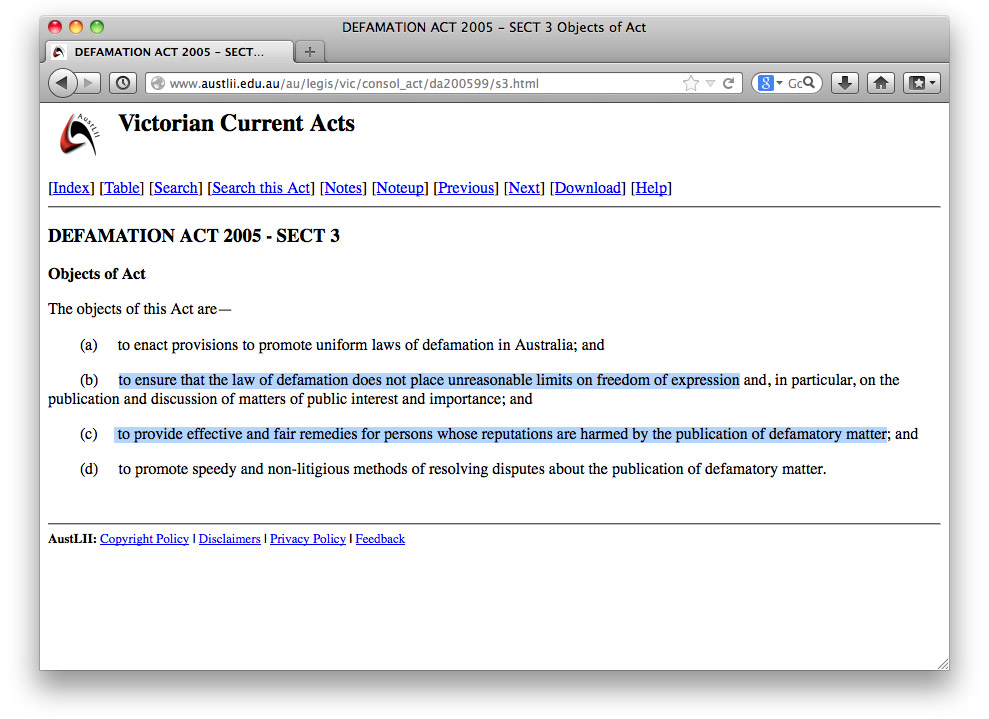 fig.
1. Anglo-Australia’s famous Censorship
Act 2005 Defamation Act 2005. The
legal industry claim that this law seeks to
prevent the “defamation” of its citizens by
keeping the truth from being imparted lest
truth destroys whatever a lie it is that
someone claims their reputation to be. At the
same time Anglo-Australian law claims that it
strikes a balance that also permits the right
to impart and receive information. Bullshit.
Employing the linguistic sleight-of-hand of
the English language, this law ascribes as a
corollary to "fame", a positive value
(similarly, the English language does the same
with the word “luck”) to claim that the
corollary to “defamation” is a negative that
subtracts from the positive attribute “fame”
is claimed to have. However, "fame", like
“luck” is blind to any "positive" or
"negative" attribute. A person hit by a bus is
lucky, not unlucky, for to be without luck
(unlucky) and hit by a bus would mean one
contrived to be hit by a bus, which would have
nothing to do with their luck. Luck is blind
chance. Likewise, a person’s fame is that
which the actions one has done say it is.
Where it otherwise, “fame” would instead be a
lie, or what you want it to be regardless of
what the truth is. Therefore, Anglo-Australian
law by deliberately dispensing with truth
being a necessary ingredient in what defines
one's "fame" is about protecting the lie,
"fame", from injury. It is a simple logical
corollary: if truth can injure a reputation,
then that reputation is a lie.
Anglo-Australians construct laws to defend
liars and cheats. Robert Cripps lied to induce
us to exhibit at his GLG (misleading and
deceptive conduct), and by lying cheated us of
money: we paid to "exhibit" at his gallery
based on his lies (inducements). He made a
profit at our expense (we paid him for
something we were prevented from receiving,
and had paid him in advance). And the law is
now allowing him to sue because the truth
injures his reputation and because the truth
causes injury one has the right to sue to have
it censored.
fig.
1. Anglo-Australia’s famous Censorship
Act 2005 Defamation Act 2005. The
legal industry claim that this law seeks to
prevent the “defamation” of its citizens by
keeping the truth from being imparted lest
truth destroys whatever a lie it is that
someone claims their reputation to be. At the
same time Anglo-Australian law claims that it
strikes a balance that also permits the right
to impart and receive information. Bullshit.
Employing the linguistic sleight-of-hand of
the English language, this law ascribes as a
corollary to "fame", a positive value
(similarly, the English language does the same
with the word “luck”) to claim that the
corollary to “defamation” is a negative that
subtracts from the positive attribute “fame”
is claimed to have. However, "fame", like
“luck” is blind to any "positive" or
"negative" attribute. A person hit by a bus is
lucky, not unlucky, for to be without luck
(unlucky) and hit by a bus would mean one
contrived to be hit by a bus, which would have
nothing to do with their luck. Luck is blind
chance. Likewise, a person’s fame is that
which the actions one has done say it is.
Where it otherwise, “fame” would instead be a
lie, or what you want it to be regardless of
what the truth is. Therefore, Anglo-Australian
law by deliberately dispensing with truth
being a necessary ingredient in what defines
one's "fame" is about protecting the lie,
"fame", from injury. It is a simple logical
corollary: if truth can injure a reputation,
then that reputation is a lie.
Anglo-Australians construct laws to defend
liars and cheats. Robert Cripps lied to induce
us to exhibit at his GLG (misleading and
deceptive conduct), and by lying cheated us of
money: we paid to "exhibit" at his gallery
based on his lies (inducements). He made a
profit at our expense (we paid him for
something we were prevented from receiving,
and had paid him in advance). And the law is
now allowing him to sue because the truth
injures his reputation and because the truth
causes injury one has the right to sue to have
it censored.
But apparently, this is not supposed to be a
censorship law? Who's kidding who here?
|
According
Anglo-Australian law, Cripps has a legal right to:
a) act as awfully as he wants;
b) to act unlawfully: and
c) to conspire with others (his staff at GLG) to
commit unlawful acts to prevent his unlawful actions
from becoming known.
Defamation law assures for him a right to sue anyone
who imparts to another how he acted, because by
writing about how he acted, the reader will think less
of him because he acted this way regardless that it is
true. And, since one can be sued for imparting
information, it is better to impart no information at
all; censorship.
DEFAMATION LAW IS THE MEANS BY WHICH ANY PARTY WITH
SUFFICIENT FUNDS CAN "INDUCE" ANOTHER PARTY TO REMOVE
INFORMATION SIMPLY BECAUSE THEY DO NOT WANT THAT
INFORMATION BEING AVAILABLE.
But apparently, this is not supposed to be a
censorship law? Who's kidding who here?
[
------------------- extracted
extracted extracted extracted extracted extracted
extracted extracted
------------------- ]
Dawn
Tan held an exhibition at Cripps’ failed Guildford
Lane Gallery. She posted a summary of her unfortunate
encounter with Cripps on her personal blog in which
she enumerated Cripps’ many bizarre antics which were
of a similar nature to those we experienced.
In late July 2013 I emailed Tan. Below is her blog at
4:03 PM 26/7/2013 (fig. 14)

fig. 14. Dawn Tan’s page
enumerating Cripps’ many bizarre antics.
Tan’s
page had been posted (according to the date on it)
since Monday 11 October 2010. This was close to 6
months before we were sued by Cripps. According to
Cripps, we caused his business to fail, not his
actions of the kind of which we as well as others
wrote about. And Tan’s page lists the kind of actions
that would cause his business to have failed.
Defamation law intends to allow Cripps to act as badly
as he wants, and act as badly as he wants to as many
people as he wants, so that despite acting in this way
he will suffer no adverse effects from his acting
badly. If Anglo-Australian defamation law intended
something different, it would have been framed
differently.
Australia’s bizarre defamation law is deliberately
framed in such a way so as to permit people like
Cripps to claim that they could only have suffered
damage because someone - us in this case - wrote about
their awful actions. According to Anglo-Australian law
having acted badly does not cause problems; writing
about someone acting badly does. And the author can be
penalised for writing about it. The law allows those
who act badly to sue, and as such the law intends to
encourage bad acts. And to repeat, if Anglo-Australian
defamation law intended something different, it would
have been framed differently.
I emailed Tan to ask her about what she had
experienced, explaining that I and Lee-Anne Raymond
are being sued by Cripps for writing about our
experience of him. After I contacted Tan her page
“vanished” (fig. 15).

fig. 15. Tan pulled her page that had
been available from October 2010 to July 2013 after
I emailed her telling her that I was being sued by
him because I wrote of what he did to us.
Tan’s
partner, Darren, telephoned me and was adamant that
Tan would not be a witness to Cripps’ actions during
her exhibition, and would even go so far as to claim
what was written on her blog was actually taken from
mine and Lee-Anne's writings - even though the
material she wrote of was unique to her exhibition
experience with Cripps.
Cripps' actions were typical Cripps at this Fully Six
exhibition! For example, Tan had written that Cripps
demanded that no written material would be allowed,
and that if written material was necessary, then the
artists should just staple written material onto the
frames of the works exhibited!
Tan wrote:
“Even
our work descriptions weren't allowed to be taped onto
the walls. Honestly, which gallery does that? ... We
weren't even allowed to blu tac our tiny little bios
onto the walls. He suggested we staple-gun my friend's
bio, onto her frame”
The artists who exhibited at this exhibition did
ultimately comply with Cripps’ bizarre demand. The
works by one of the graphic artists participating in
the “Fully Six” show exhibited at GLG, Jessica Hyde,
can be seen with the information stapled onto the
frames. As Tan asks "which gallery does that?"

fig. 16. Cripps demanded artists
staple their information onto the frames of their
work. Jessica Hyde’s works have the descriptions
stapled directly onto the frames. (I emailed Jessica
Hyde and she responded that she did not hang her
works there herself.) The stapling of the
information onto the frames diminishes the artist,
it's amateurish. Without Tan’s written explanation,
one is more likely to think little of the artist who
stapled their information onto their frames, because
they would be unaware that the gallery owner,
Cripps, had demanded this to be done.
Will
the “ordinary” or “reasonable” reader find the
stapling of information onto the frames to be
“defamatory”? I doubt it.
The stupidity of the “ordinary” or “reasonable” reader
is boundless.
The “ordinary” or “reasonable” reader would think
nothing of Cripps’ bizarre demands and this would mean
that Cripps is not defamed.
However, by making such a reader aware of why these
are idiotic demands, one will defame Cripps because it
will cause such a reader to think very little of
Cripps! The “ordinary” or “reasonable” reader would
come to understand why someone who claims to be
“professional gallerist” but who makes such ridiculous
demands is really just an idiot.
The placing of disclaimers, along with the forcing of artists to staple their descriptions, bios, and explanatory texts onto their frames would destroy any gallery that enforced such practices. No artist would ever pay Cripps to exhibit their works in his gallery. Such a gallery would very obviously be one that is run by someone who should not be in the industry.
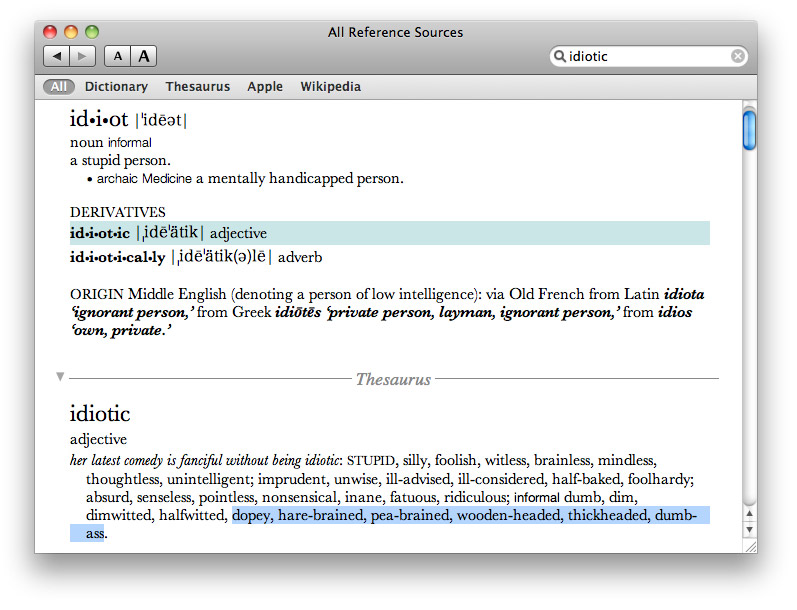
fig. 17. definition of “idiot”.
Cripps is a man of limited intellect and limited in
his erudition.
BOXING
DAY VISIT TO THE NGV 2013: Why Cripps is an idiot
for posting disclaimers in our exhibition and
demanding that information is to be stapled onto
frames during the exhibitions by others:
During our exhibition at Cripps’ gallery we posted
explanatory essays alongside the works exhibited (eg.
fig. 3). What was posted was taken from a publication
we produced to accompany the exhibition. There is
nothing unusual in either producing a publication, or
in placing explanatory texts alongside art works.

fig. 18. Painting hung at the NGV,
with the artist’s biographical information and an
explanation of the work posted onto the wall to the
left of the painting.
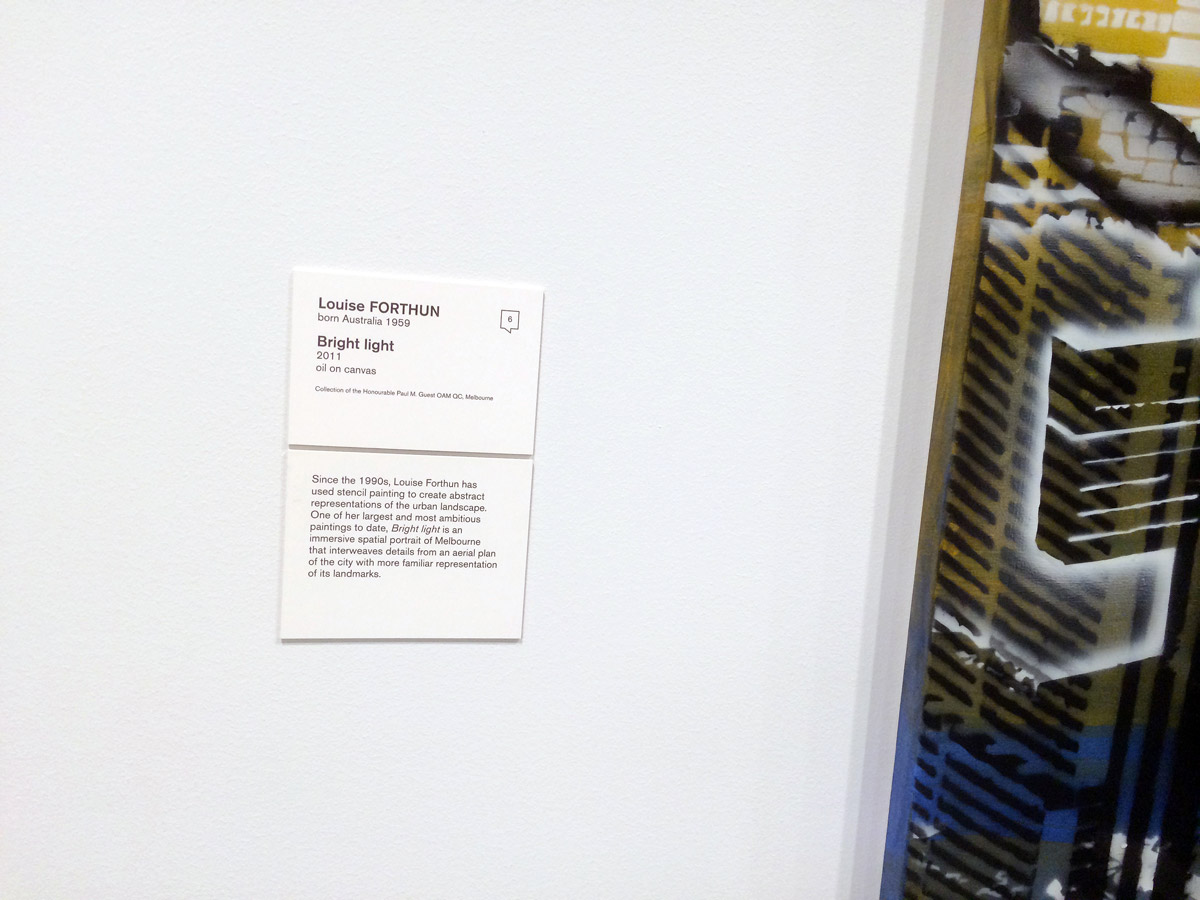
fig. 18b. The biographical
information and explanation to the work in fig. 18.
The painting intends "to create abstract
representations"; "is an immersive spatial
portrait"; and is not a "familiar representation".
During our show Cripps placed a disclaimer of
liability because he claimed the art was “racist”.
On suing us Cripps is claiming that this disclaimer
was instead due to “complexity”, and is suing me on
the grounds that “ordinary” or “reasonable” readers
won’t know the meaning of “big words” like
“manifestation”. Under such circumstances a painting
that intends "to create abstract representations"
and "is an immersive spatial portrait" would be
way-too complex and should necessitate a "Crippsclaimer"
(being a disclaimer on the grounds of complexity).
According to Cripps it should have been expressed
more simply (Refer Tao Jiang's farcical Points of
Defence
http://www.redlegvartists.com/Points_of_Defence_ORC-comments.pdf).

fig. 19. Painting by the Symbolist
Pierre Puvis de Chavannes. Anyone reading my own
biographical writings will read about about the
symbolists, as well as the surrealists. Chavannes,
according to the text beside the work, painted
"allegorical schemes"; with a "tendency to a …
non-narrative style". However, this description is
way-too complex and should make necessary a Crippsclaimer
(being a disclaimer on the grounds of complexity).
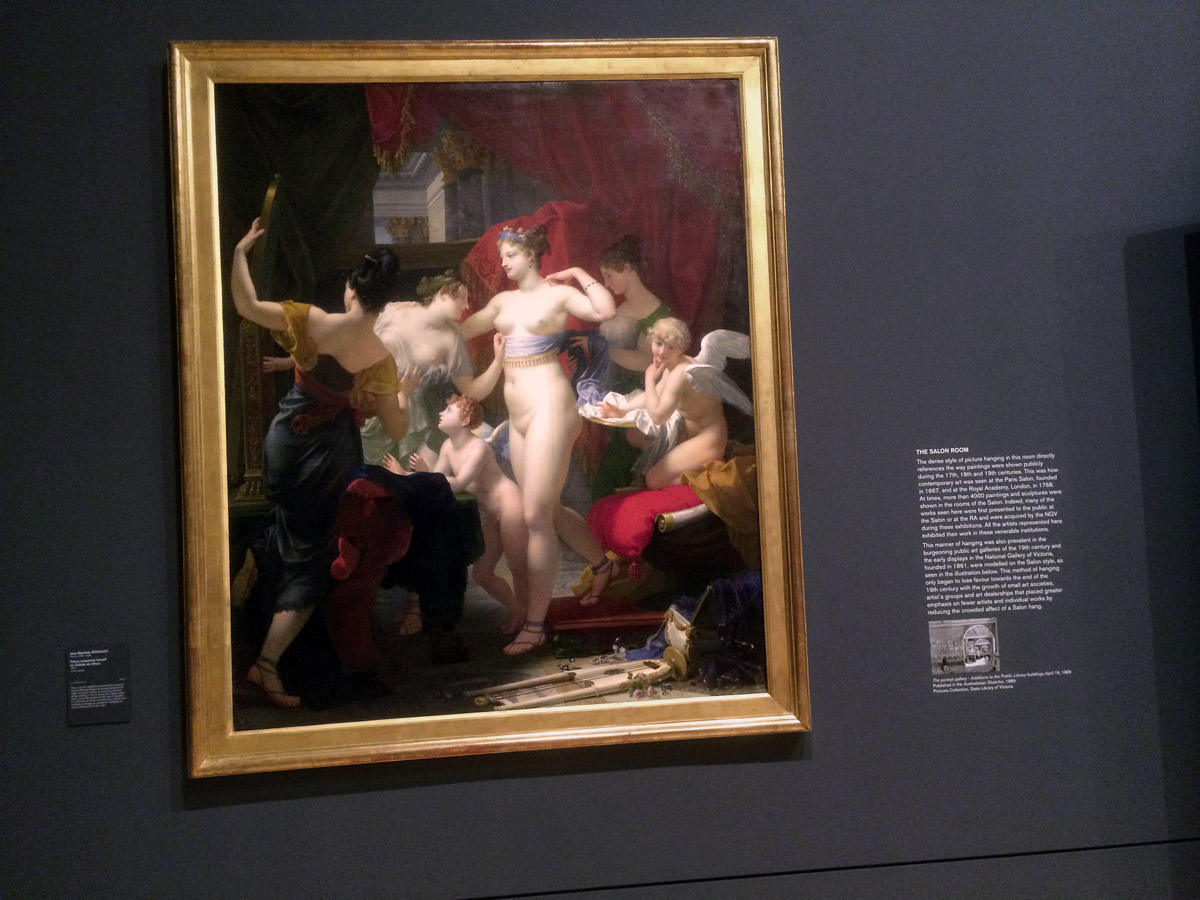
fig. 20. The “Salon Room” at the NGV.
The painting by Jean-Baptiste Regnault is in the
centre with a biographical note to its left and an
explanatory text of what a “Salon Room” is to the
right. According to Cripps this information should
have been stapled onto the frames (refer fig. 16),
that is, the work should have been “Crippsed”.
|
|
|
| fig. 21. St Catherine statue.
The information text is affixed to the gallery
wall to the left and behind the statue. |
fig. 21a. Now fixed and much
better! St Catherine statue. According to
Cripps the information should have been
affixed onto the frames, or, in this case, the
object itself, not the gallery wall (refer
fig. 16). This is how it would have appeared
had it been Crippsed. |
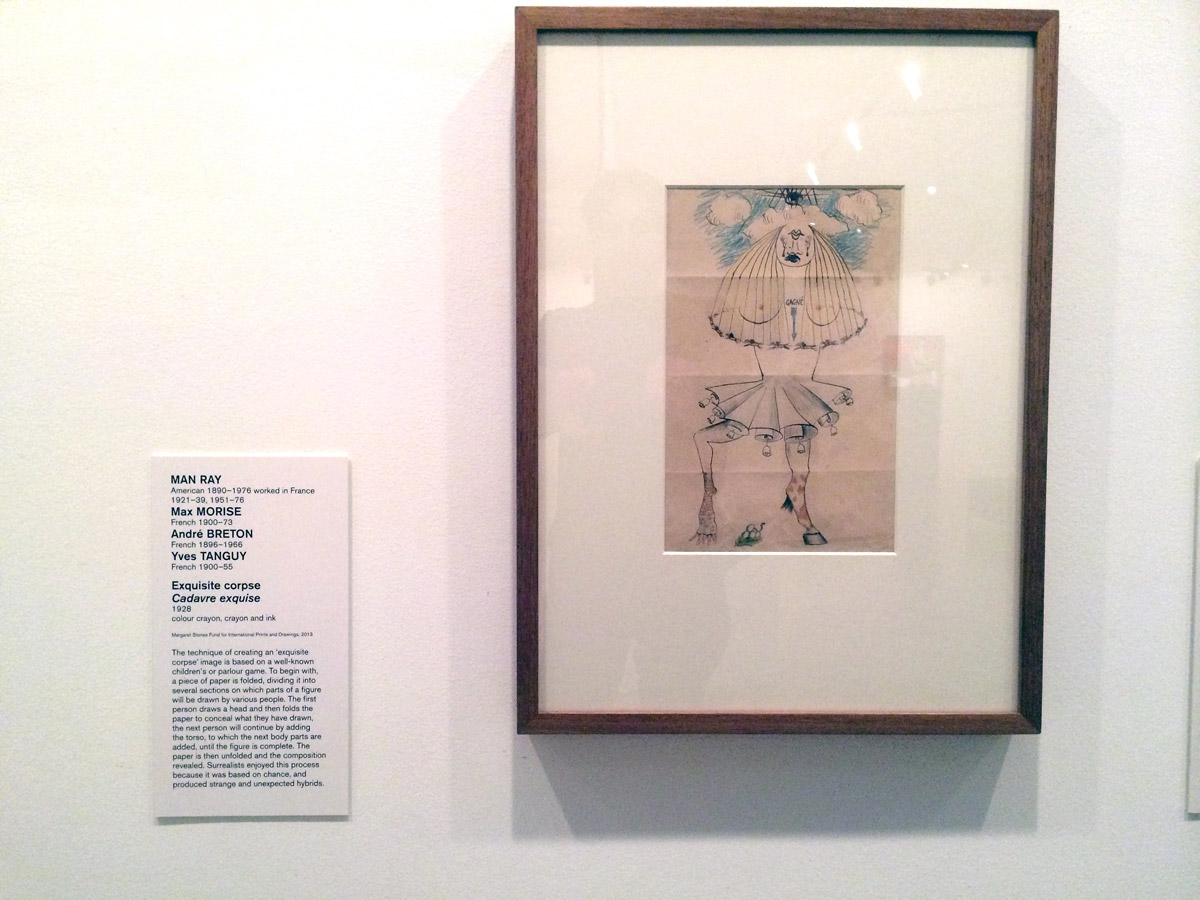
fig. 22. The NGV made new
acquisitions in 2013, that were not on show during
our previous visit on September 2013 (I may have
missed them?). Above a recent acquisition of a
surrealist exquisite corpse. The explanatory text is
on its left.

fig. 22a. Now fixed and much better!
According to Cripps the explanatory text should have
been affixed onto the frame (refer fig. 116). In the
Cripps universe this would improve its aesthetics.
This is how it would have appeared after being Crippsed.
The text panel explains it is the art of "chance"
which produced "strange and unexpected hybrids".
This explanation means that it would have required a
Crippsclaimer too, lest that which is
unexpected unexpectedly turns out to be complex.
Calling it an "exquisite corpse" definitely should
have elicited a Crippsclaimer!

fig. 23. Painting by Max Ernst with
an explanatory text to its right, and an even larger
explanatory text on Surrealism to the right of it.
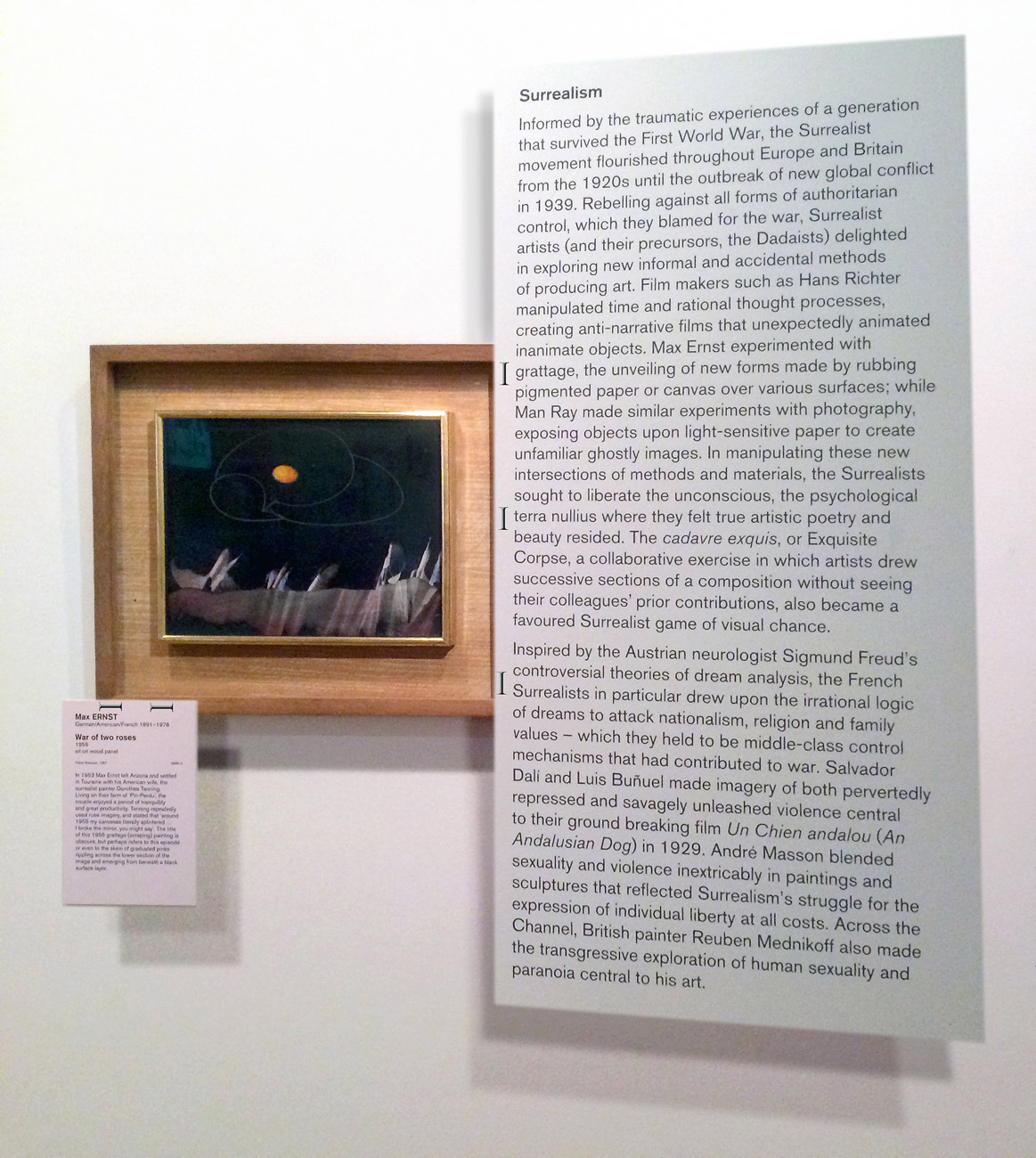
fig. 23a. Now fixed and much better!
Painting by Max Ernst as it would appear had it been
Crippsed. This work would definitely
require a Crippsclaimer! The
explanatory essay, a succinct synopsis of
surrealism, explains that surrealism was a rebellion
"against all forms of authoritarian control", that
its practitioners drew on the "irrational logic of
dreams", "attacke[d] nationalism, religion…
mechanisms that had contributed to war", with themes
that include "sexuality and violence inextricably
[blended]", and was "transgressive". This should
have required not only a Cripsclaimer
but a large WARNING!
(eg. fig. 6).
|
|
|
| fig. 24. Chinese steamer with
two pieces of explanatory text. |
fig. 24a. Now fixed and much
better! Chinese steamer as it might appear on
being Crippsed. Sure, it covers
up sections of the object, but it's worth
doing so for the sake of aesthetics! The
explanation of what this object is would
appear to be non-controversial and
uncomplicated enough to not require a Crippsclaimer,
HOWEVER, one can never ever be too sure! |

fig. 24b. WARNING!
WARNING! WARNING! The
Chinese “steamer”, may not quite be a simple
steamer. It represents 3 Chinese Taotie, a stylised
snarling face, which sometimes exposes fangs,
sometimes has a protruding tongue, and sometimes
both. (This information is not provided by the NGV).
Conceptually it is related to the Greek Gorgons
(Euryale, Medusa and Stheno). As this is WAY TOO
COMPLEX (!!) it should have required a Cripsclaimer!
as well as a WARNING!
(eg. fig. 6).
Tan's
redacted page included many negative comments about
Cripps made by readers of her blog. One of the
commenters, Jacinta Moore (friends on Facebook with
one of Cripps' staff, Stacey Jewell), wrote that she
too had a similar experience with Cripps when she was
leaving the gallery at the conclusion of her
exhibition opening. She has not responded to several
messages that I sent her (fig. 25).

fig. 25. Jacinta Moore "copped a bit"
of Cripps' "craziness" when she was leaving GLG. So
too did we! Moore has not responded to my emails,
and Tan has withdrawn her page. Now I know why there
was no information available on Cripps before I
exhibited at his failed gallery.
Of
course, it is no secret that the intention of
Anglo-Australian defamation law is to censor and that
it actually succeeds in achieving censorship. If one
can succeed in having people remove information -
because of their fear of being sued - then the only
information that will remain available is that which
someone like Cripps wants to remain available. What is
now available about the Fully Six exhibition for
example is what Cripps himself supplies on his now
re-furbished GLG website (figs. 26 & 26 a). That
exhibition was a resounding success! It is amazing to
see what can be achieved by the law of censorship
defamation!

fig. 26. Fully Six opening on Cripps'
refurbished GLG website (which had disappeared and
then re-appeared with some information missing).
Jessica Hyde's works (which had the information
stapled onto the frames, re fig. 16) can be seen in
one of the stills. The Fully Six opening appears to
be wildly successful!
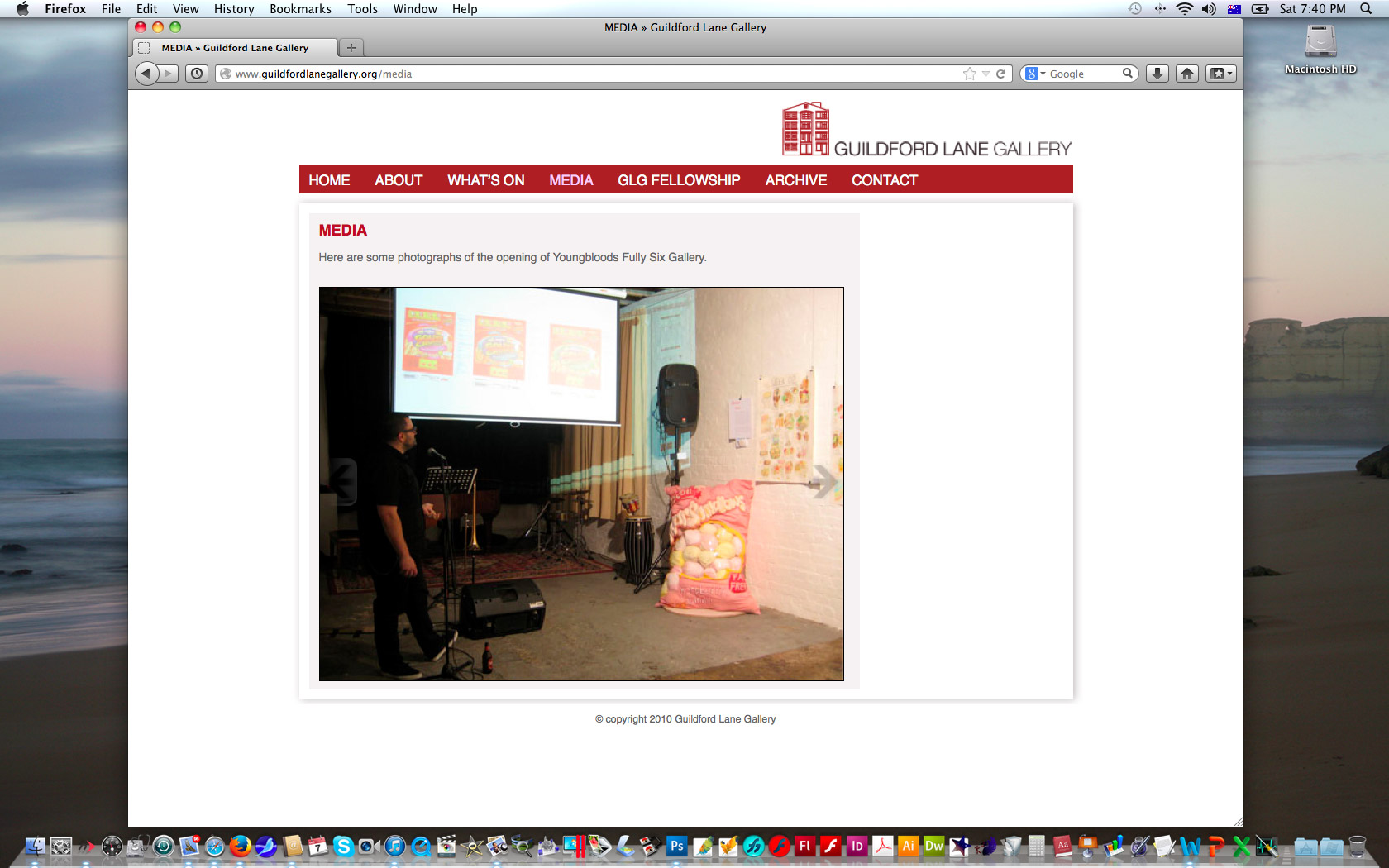
fig. 26a. Fully Six opening on
Cripps' refurbished GLG website (which had
disappeared and then re-appeared with some
information missing) showing the works of Dawn Tan.
But
apparently, this is not supposed to be a censorship
law? Who's kidding who here?
Cripps
should have been embarrassed by his actions, and
sought to remedy us for the consequences of his
acting badly. Instead Anglo-Australian law permits
him to sue us to profit over those actions for which
he owed us money (rescission of contract). Cripps
should modify his behaviour, instead the law has
allowed him to behave in a similar manner again, and
again, and again. Cripps is a ridiculous man, but
the law allows him to sue others because he makes
himself an object of ridicule. To date the reaction
from Cripps' crack legal team has appeared to be "we
just sue harder Mr. Cripps!" What kind of
bizarre law is it that would allow for this? This
question is rhetorical.
But
apparently, this is not supposed to be a censorship
law? Who's kidding who here?

[
------------------- extracted
extracted extracted extracted extracted extracted
extracted extracted
------------------- ]
(EXTRACT
the entire document is to be posted 3/3/2014)
*Edited
29/12/2013 to include fig.1 and the criticism of S.3
of the 2005 Censorship
Act Defamation Act.

Robert
Cripps, above, ran a failed-gallery
Author: Demetrios Vakras December 2013
We
are petitioning the Australian government to amend the
Defamation Act of 2005 to make Australian law
consistent with its international obligations.
Support our petition here:http://www.change.org/en-AU/petitions/the-hon-mark-dreyfus-qc-mp-amend-the-australian-defamation-act-2005
|






















